A single day Spring Tour in North Norfolk. Thankfully the wind had dropped today and even though it was cloudy and cool in the morning, the sun came out and it was blue skies in the afternoon. A nice day to be out birding.
Our first destination for the day was Stiffkey Fen. As we pulled up by the road, two Stock Doves were in the field and four more were perched on the roof of the barns nearby. A Common Whitethroat was singing and a Yellowhammer was calling, with the latter flying up from the hedge and out over the field as we walked along the path.
In the copse at the far end, we could hear a couple of Blackcaps singing against each other and managed to find a Chiffchaff singing in one of the trees just above the path. Crossing the road, we could hear a different song coming from the trees by the river, a little like a Blackcap but faster, more rolling, tumbling. It was a Garden Warbler and we had a couple of glimpses of it as it flew between the bushes, always keeping well tucked in though.
A quiet plaintive whistle alerted us to a Bullfinch in the trees by the path. It was tricky to see deep in the foliage, but then flew out past us, a smart pink male. Several House Martins were flying round over the meadow and up to the eaves of the house beyond. We had stopped to listen to a Reed Warbler which was singing in one of the big sallows, when a Cuckoo started singing up towards the seawall. We got it in the scope and most of us managed a look at it before it flew off. We could still hear it singing away to the east when we got up onto the seawall.

The tide was high already in the harbour and the saltmarsh was flooded. There were still plenty of Brent Geese swimming around among the bushes – yet to head off back to Siberia for the breeding season.
We got the scope out to scan the Fen, but there were just a few waders on here today despite the tide. We managed to find two Common Sandpipers bobbing round the edge of the islands, and a Greenshank with two Redshank in the far corner. A pair of Little Ringed Plover were chasing each other round the islands initially, before flying off past us calling. A presumed intersex Eurasian Teal, a female showing intermediate male-type characteristics, was also interesting to see.
As we made our way round towards the harbour, a Spoonbill flew past over the saltmarsh, disappearing off east towards Morston. Several Common Terns were flying around the harbour, diving into the water, and we managed to pick out a single Arctic Tern too, hunting up over the flooded saltmarsh channels.
There were not many waders around the edges of the water in the harbour now, with the tide right in, just a few Oystercatchers. However, we did manage to find a Whimbrel out on the saltmarsh, which was subsequently joined by a second. Through the scope, we could see their small size, striped crown and short bills. Another four Whimbrel flew up and circled over the saltmarsh further out towards the water.
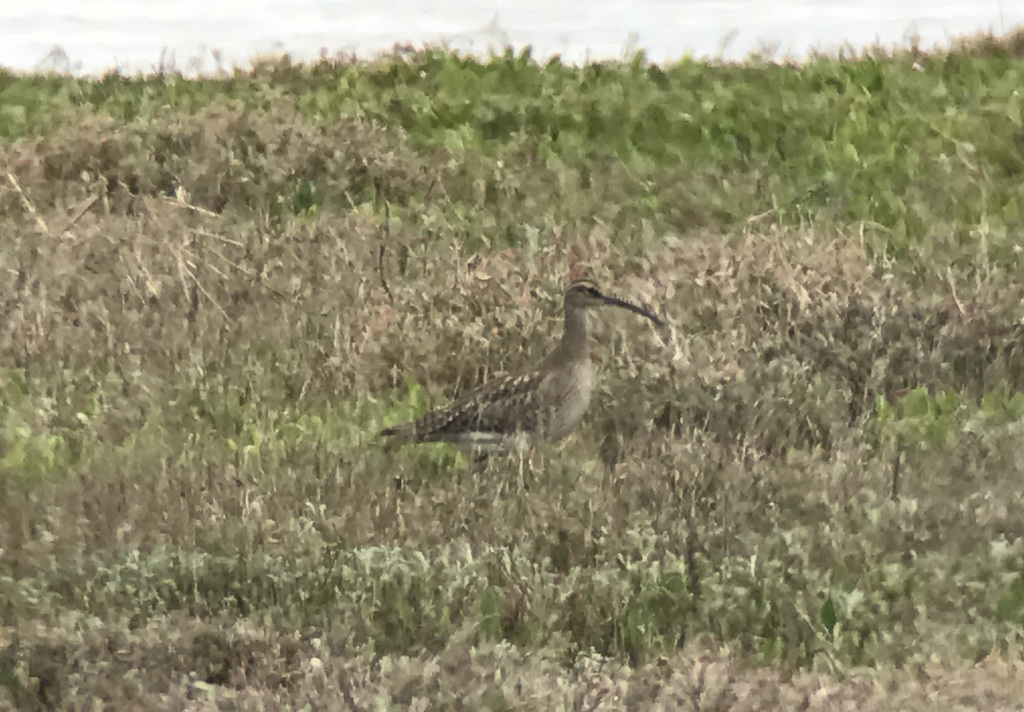
There were a few Linnets and a Kestrel in the bushes by the harbour. As we walked back, a family of Dunnocks were feeding on the path – the two youngsters, unable to fly, hopped away ahead of us and eventually scrambled back into the hedgerow.
The Sedge Warbler, which had quickly disappeared into cover when we walked past earlier, was now singing from the top of a reed stem, out in full view where we could get a good look at it through the scope. They always tend to be more accommodating than Reed Warblers and now that the wind had dropped this one was performing very well.
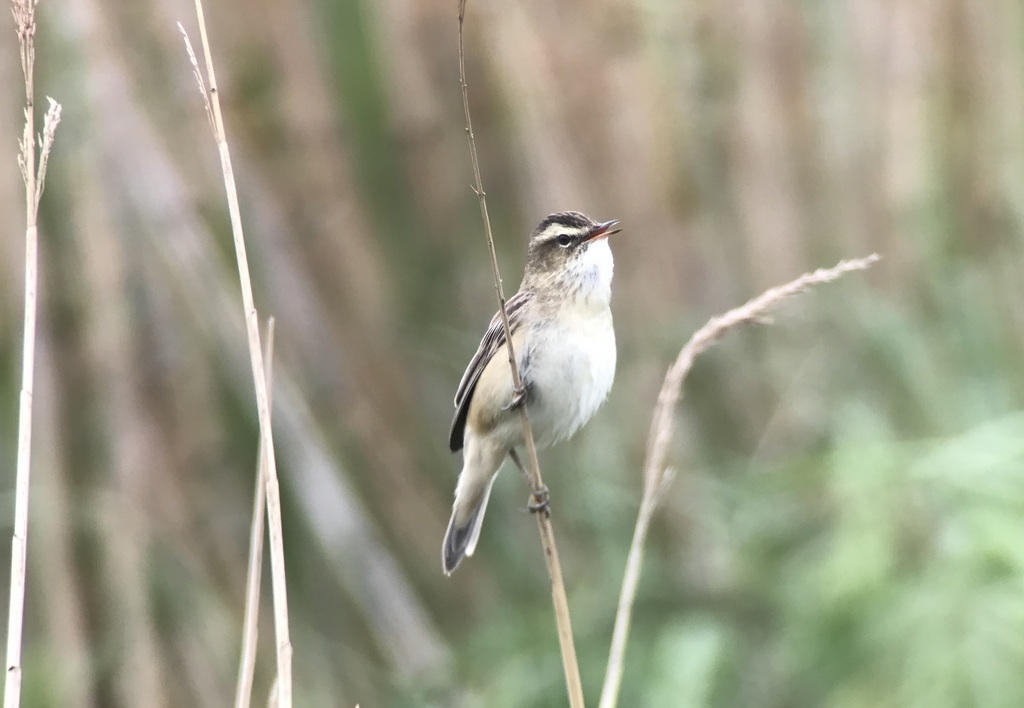
There had been one or two Marsh Harriers around the Fen. A rather pale male had flown very quickly through, before it could attract the worst of the attention from the Avocets nesting down on the islands below. However, when we got back to the car we had a much better view of one. A male Marsh Harrier was circling over the copse, and then flew towards us, passing by just over the edge of the field to the south.
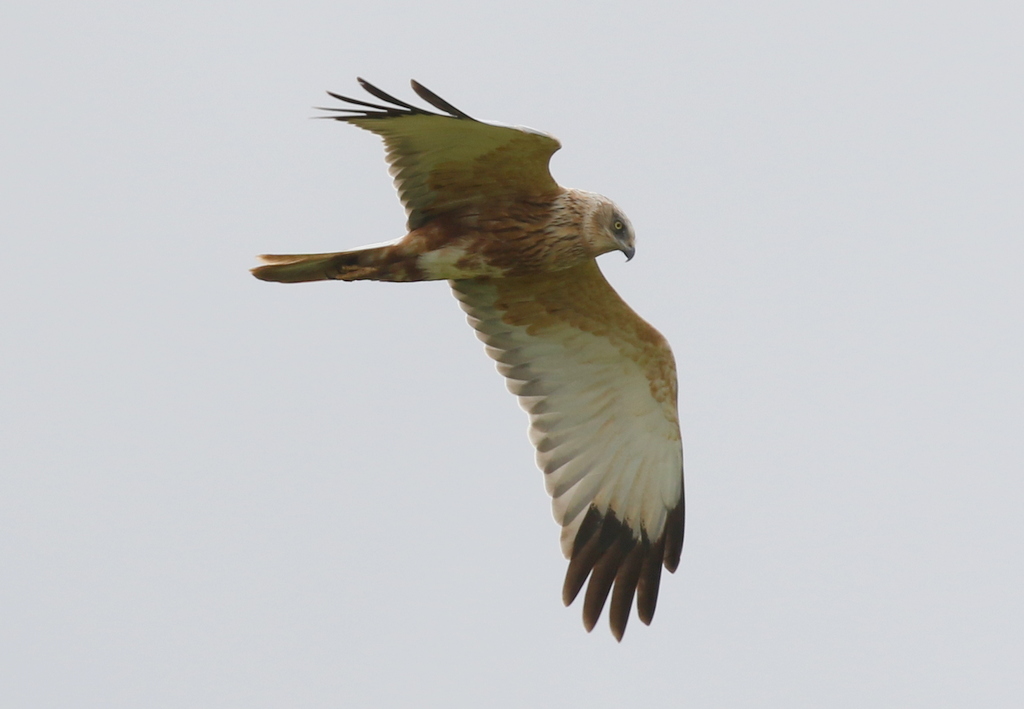
We made our way further east along the coast road to Cley next. There had been a nice selection of waders here over the past couple of days, but asking at the Visitor Centre as we got our permits, it sounded like a number of them had moved on overnight. Still, we made our way out to the hides, to see what we could find.
On the walk out, we could hear a Reed Warbler singing in the thin strip of reeds the other side of the ditch by the path. Unlike the Sedge Warbler we had seen earlier, it was keeping well down in cover. However, a careful scan and we could see it, perched about half way up through the reeds. We had a good look at it through the scope, noting its rather plain appearance and relatively unmarked face, with pale just on the lores and over the eye and a small pale crescent below.
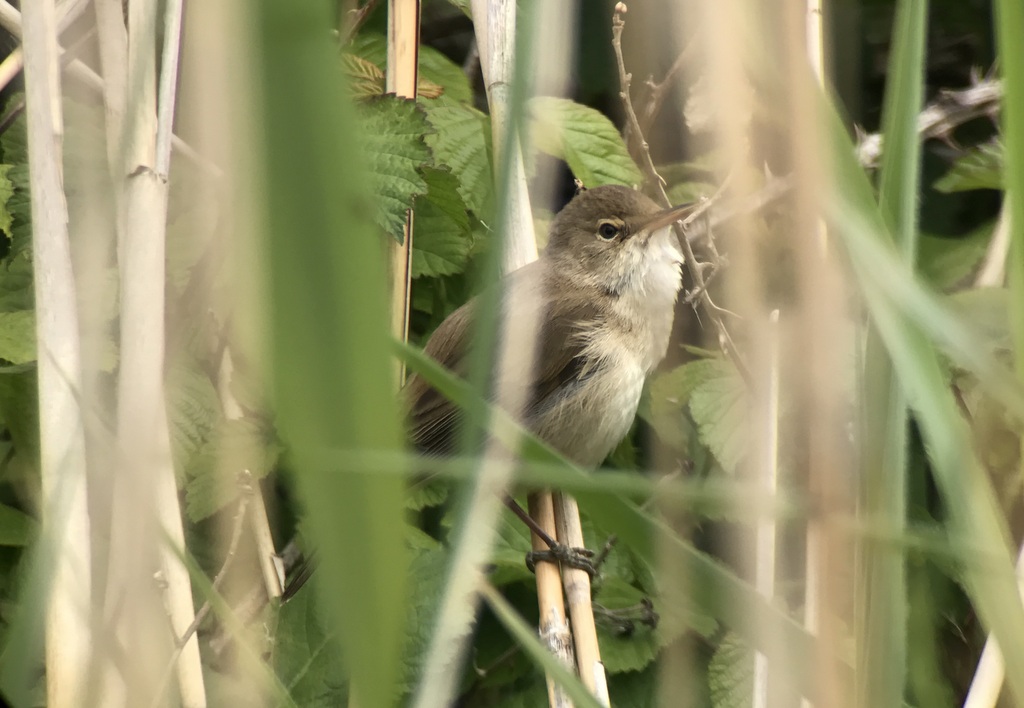
There were a few more House Martins back and prospecting the eaves of the warden’s house – good to see as numbers have been worryingly low in recent days, for the time of year. Hopefully there are more still to come.
As we got to the boardwalk, we heard a Bearded Tit calling, and turned to see a male zipping over the tops of the reeds. It flew round behind us, then out towards the hides, dropping back in further up beside the path. We walked round to where it had dropped and got there just as it flew again, but were surprised to see two or three more Bearded Tits in the reeds, perched half hidden just a couple of metres in. They were juveniles – with black masks and black backs, with their tails only half grown. The male had obviously been in to feed them, but they dropped back down before everyone could get onto them.
From Avocet Hide, a pair of Gadwall were feeding just below the windows in front, and we got a very good look at the intricate patterning of the drake. There are good numbers of Avocets nesting on here at the moment and, over towards the back, we could see that one pair already had three very small chicks. The nests at the front were still on eggs, but we watched a couple of times as the other adult flew in, stopped to preen for a couple of minutes and then walked over and took over incubation duties from its partner.
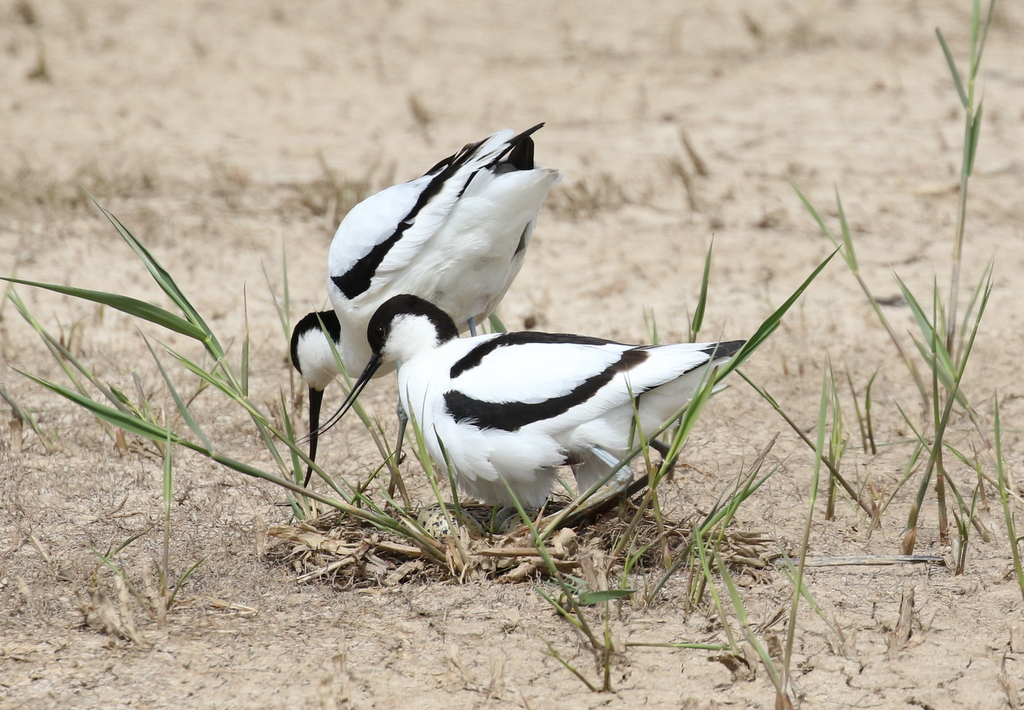
There were not that many other waders on here though today. A single Little Ringed Plover was busy preening on the top of the island amongst the nesting Black-headed Gulls. A lone Black-tailed Godwit was feeding in the deeper water between the islands. We had a good look for the Temminck’s Stint just in case, around the reedy margins of the scrape where it had been yesterday, but we couldn’t see any sign of it and it hadn’t been seen all morning today.
Round at Dauke’s Hide, there were lots more Black-tailed Godwits, a few starting to come into rusty breeding plumage, but mostly in shades of grey/brown. The Avocets were chasing them whenever they came within range of a nesting pair and we had great views of two godwits squabbling on the bank in front of the hide.

A striking mostly summer-plumage Ruff, largely black with an already well-developed dark barred ruff, was feeding around the edge of one of the islands. A couple of Tundra Ringed Plovers were feeding on the mud at the back, but there was no sign of any of the Dunlin or Curlew Sandpipers from yesterday – it appeared that some of the waders had moved on with the drop in the wind.
Looking across to Pat’s Pool, we could see more Black-tailed Godwits feeding just beyond the bank at the front. There were two female Ruff, also known as Reeves, with them, much smaller than the males and plainer grey brown, patterned with dark. A couple more male Ruff coming into breeding plumage were feeding around the islands further back.
Two Bar-tailed Godwits dropped in with the Black-tailed Godwits, stopping to preen next to them for a few minutes before going to sleep. They were presumably migrants, stopping off for a break on their way north. We had a nice side-by-side comparison of the two species together, and the shorter legs of the Bar-tailed Godwits were particularly obvious, with them up to their bellies in the water whereas we could see a good length of leg still on the Black-tailed Godwits.
It was time for lunch, so we made our way back to the Visitor Centre. It had started to brighten up nicely now, so we made good use of the picnic tables overlooking the reserve. An adult Mediterranean Gull circled high overhead with several Black-headed Gulls.
After lunch, we made our way over to the East Bank. There were several Lapwings and Redshanks around the small pools on the grazing marsh as we walked up towards the sea. A lone lingering drake Wigeon was on the north end of the Serpentine, along with a Common Sandpiper nearby. We could just see a single Little Ringed Plover out on Pope’s Pool at back.
There is not too much on Arnold’s Marsh at the moment, but we did see a pair of Little Terns on the small island out towards the back. A Grey Plover flew in to join them and a bright summer-plumage Turnstone was a nice addition to the day’s list. We had a quick look out at the beach, but there was nothing moving out to sea today.
We had received a message on the walk out to say that the Temminck’s Stint had reappeared on the scrapes, so we decided it was worthwhile heading back round there to try to see it. As we walked back along the bank, a couple of Little Egrets flew past. One landed down by the bank, feeding on a small pool. It is good to see a few Little Egrets back here, after we lost a good number in the cold weather over the winter.
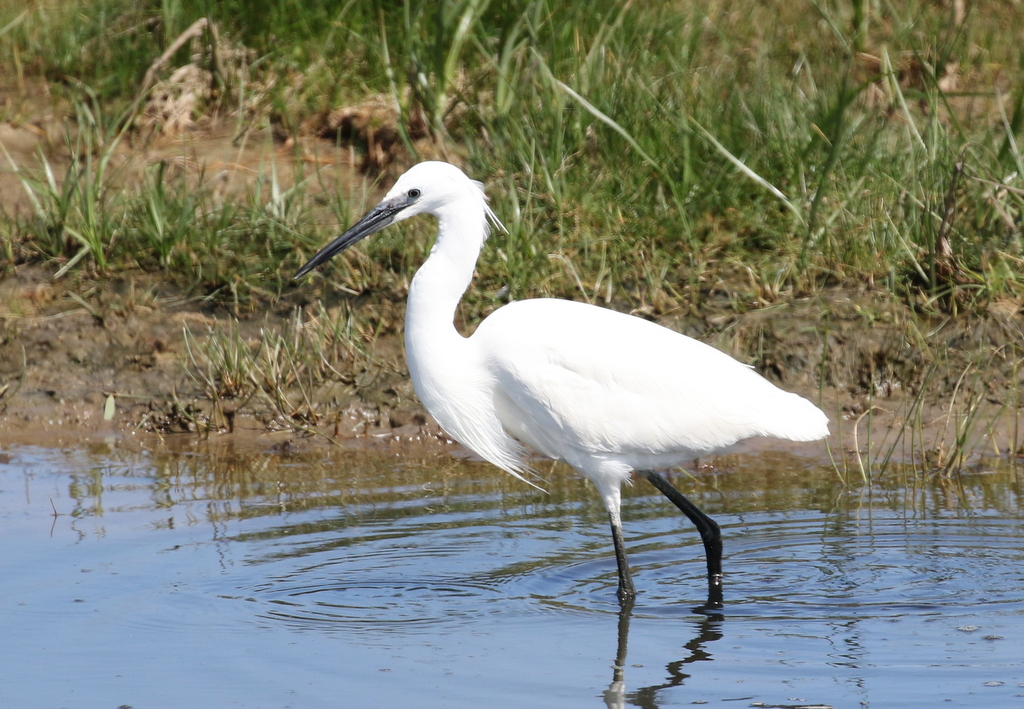
When we got back round to Avocet Hide, we quickly got onto the Temminck’s Stint, creeping around on the back edge of the scrape, just where it had been yesterday and we had looked for it earlier. Second time lucky! It was very well camouflaged against the mud but we could see its yellowish legs and pattern of scattered dark-centred feathers in the upperparts.
While we were watching the stint, we noticed a small female Ruff walking past one the males over on Simmond’s Scrape. The male Ruff started displaying, puffing out its ornate ruff feathers, drooping its wings and bowing. The female seemed particularly unimpressed and carried on feeding, working its way slowly along the edge of the island.
That took the female Ruff within range of a second male, which had been preening quietly further back. The first male chased over to it and the two of them had a brief tussle, rearing up and kicking out at each other, Both then started displaying, but the first was clearly dominant and after a couple more scuffles, the second Ruff sloped off back through the grass.
The first male Ruff then had the female to itself, and tried more display, bowing again, before crouching down, back to her with wings spread. Still the female seemed decidedly unimpressed and carried on round the back of the island. It was amazing to watch – we get Ruffs here over the winter and passing through in spring, but they head off to the continent to breed so it is rare to see them displaying here.
When we left the hide, we could hear the Bearded Tits still in the reeds by the boardwalk. The adult female came in a couple of times to feed the juveniles, and we had a better looks at the young ones perching in the reeds this time.

Returning to the car, we headed back west to Holkham, a little later than planned. As we walked west along the path on the inland side of the pines, we could hear Blackcap and Chiffchaff singing, and the sweet descending scale of a Willow Warbler. A drake Mallard and a family of Moorhen were the only birds on Salts Hole this afternoon.
Just beyond, we stopped to listen to a Goldcrest singing in the trees, and found it flitting around in the tops of the elms, just below the pines. A Coal Tit was in the pines nearby too. As we walked on, a Cuckoo started singing in the trees just behind us.
It was nice and sunny now, and warmer in the lee of the pines. There were a few more butterflies out – several Orange Tips, a few whites, a Peacock. A striking Green Hairstreak landed on the path in front of us.

We made our way straight out to Joe Jordan Hide. It was quiet at first, but quickly the Spoonbills started to appear. First one flew in from the east, and dropped down into the trees, then another two flew in from the west. After a whole, one or two started dropping down onto the pool below the trees and through the scope we got a better look at their distinctive spoon-shaped bills. We could also see the shaggy nuchal crest on one, a sign of a bird in breeding condition.
While watching the Spoonbills through the scope, a Great White Egret flew in and landed on the pool just in front of them. It flew again, and this time landed just to the right of the hide. We had a great view of it here – particularly its long, yellow bill.

There were a few Little Egrets flying in and out of the trees too, and several Grey Herons. Marsh Harriers were coming and going and there were lots of Greylags and the odd Egyptian Goose out on the grass. A Mistle Thrush dropped out of the trees to feed on the bank in front of us.
Unfortunately, it was time for us to head back. We had one more bird to add to the list as we were leaving, with a pair of Grey Partridge feeding on the grazing marsh by Lady Anne’s Drive as we drove out. A nice way to finish a very enjoyable day out.

















